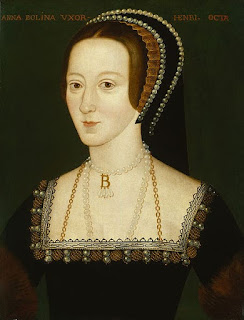The Coronation of Anne Boleyn - 1st June 1533
487 years ago, on this day, a pregnant Anne Boleyn was crowned Queen of England at Westminster Abbey.
The month of May was marked by the anniversary of Anne Boleyn’s trial and execution in 1536, with many people exploring the manner and circumstances leading up to and surrounding her trial. But it was only three years before her demise, on 1st June 1533, that she had been crowned Henry’s queen.
Anne Boleyn’s coronation was a lavish and elaborate affair; it had begun days earlier on 29th May, where Anne was escorted by a florilla of barges up the River Thames to the Tower of London. She rested there for two nights, whilst the creation of the new Knights of Bath took place. Interestingly, one of the new Knights was Sir Francis Weston, who would later be accused of high treason and adultery with Anne Boleyn in 1536.
Then on the 31st May, Anne was carried through the streets of London, from the Tower to Westminster, in a procession of hundreds of courtiers, ladies and officials, the streets lined with clothes of scarlet, crimson and blue, with tapestries and carpets, drawing in crowds of people to watch the spectacle of the new Queen to be.
Finally, on 1st June, Anne was led from the Palace of Westminster to Westminster Abbey. A visibly pregnant Anne was received at the High Altar where she was crowned and anointed as Queen consort of England. It is interesting to note that Anne was crowned with the crown of St Edward, which was only used to crown monarchs, and it has been suggested by historians that a possible reason for this was because it was widely presumed that the baby Anne was carrying was a boy and therefore the future King of England.
This had been a long journey for Anne, and we can only imagine the relief and joy she felt. After seven years of courtship, this was a moment of triumph for her, Anne was finally crowned as Henry’s Queen. Although it would only be three years later that she would be tried and beheaded for adultery, incest and treason, Anne’s mark on history was unlike any other queen before her. As argued by Eric Ives, Anne was “the most influential and important queen consort England has ever had.” Anne had provided the reason for Henry to seek a divorce from Catherine of Aragon and break from Rome and papal authority, thus causing the English Reformation, the creation of the Church of England and appointment of Henry as its Supreme Head. They were political, legal and religious transformations that England hadn’t experienced since the Norman Conquest, and which would affect many generations to come.
Despite Anne’s early and tragic demise, the child Anne was carrying during her coronation, who many presumed would be the long awaited heir and future King of England, became the beloved Virgin Queen, Elizabeth I, whose 44 years on the throne would bring stability to a country that was arguably brought to chaos by her father, because of her mother.
Sources:
Ives, Eric, The Life and Death of Anne Boleyn, (2004).
Alice Hunt, The Drama of Coronation: Medieval Ceremony in Early Modern England, (2008).
https://en.wikipedia.org/wiki/Anne_Boleyn
Pictures:
Anne Boleyn by Unknown English artist, oil on panel, late 16th century, based on a work of circa 1533-1536, NPG 668.
Apollo and the Muses on Parnassus, by Hans Holbein the Younger, (1533). A street tableau for the coronation eve procession of Anne Boleyn on 31 May 1533.
The coronation procession of Anne Boleyn to Westminster Abbey (from a drawing by David Roberts in the Tyrell Collection), illustration from The History of Protestantism by James Aitken Wylie (1808-1890), published 1878.
Natalie Dormer as Anne Boleyn, in the TV Series The Tudors.
Claire Foy as Anne Boleyn in the TV miniseries Wolf Hall.






Comments
Post a Comment